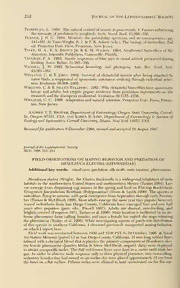
Field observations on mating behavior and predation of Hemileuca electra (Saturniidae) PDF
Preview Field observations on mating behavior and predation of Hemileuca electra (Saturniidae)
212 Journal of the Lepidopterists' Society TlNBERGEN, L. 1960. The naturalcontrol ofinsects in pine-woods. I: Factors influencing the intensityofpredation bysongbirds. Arch. Neerl. Zool. 13:266-336. Turn1e4r1-,16J.1.R.InG.Van1e9-8W4r.igMhitm,icRr.yI:. t&heP.paRl.atAacbkielirtyy(sepdse.c),trTuhmeabnidoliotgsycoofnsbuetqtueerfnlcieess,,2pnpd. ed. Princeton Univ. Press, Princeton, NewJersey. Tyler, H. A., K. S. Brown Jr. & K. H. Wilson.' 1994. Swallowtail butterflies of the Americas. Scientific Publishers, Gainesville, Florida. VAUGHAN, F. A. 1983. Startle responses ofblue jays to visual stimuli presented during feeding. AWnim. Behav. 31:385-396. WENZEL, J. 1992. Behavioral homology and phylogenv. Ann. Rev. Ecol. Syst. 23:361-381. WlKLUND, C. & T. JARVI. 1982. Survival of distasteful insects after being attacked by naive birds: a reappraisal ofaposematic coloration evolving through individual selec- tion. Evolution36:998-1002. Wiklund, C. & B. Sillen-Tullberg. 1985. Whydistastefulbutterflieshaveaposematic larvae and adults, but cryptic pupae: evidence from predation experiments on the monarch andthe European swallowtail. Evolution39:1155-1158. WILLIAMS, G. C. 1966. Adaptation and natural selection. Princeton Univ. Press, Prince- ton, NewJersey. AndrewV. Z. Brower, DepartmentofEntomology, Oregon State University, Corval- lis, Oregon 97331, USA, and Karen R. Sime, Department ofEntomology 6- Section of Ecologyand Systematics, Cornell University, Ithaca, New York 14853, USA. Receivedforpublication 6December1996; revisedandaccepted28August 1997. JournaloftheLepidopterists'Society 52(2), 1998,212-214 FIELD OBSERVATIONS ON MATING BEHAVIOR AND PREDATION OF HEMILEUCAELECTRA (SATURNIIDAE) Additional keywords: visualcues,predation, silkmoth, matelocation, pheromones. Hemileuca electra (Wright), the Electra Buckmoth, is awidespread inhabitant ofxeric habitats in the southwestern United States and northwestern Mexico (Tuskes 1984). Lar- vae emerge from diapausing egg masses in the spring and feed on Flat-top Buckwheat, Eriogonumfasciculatum Bentham (Polygonaceae) (Stone & Smith 1990). The species is univoltine, flyinginautumn,withpeakemergencefrom Septemberthrough earlyNovem- ber(Tuskes & McElfresh 1995). Mostadults emergethe sameyeartheypupate; however, reared individuals from San Diego County, California have emerged four and one half years after pupation (pers. obs., Powell 1987). Adults are diurnal, non-feeding, and brightlycolored (Ferguson 1971,Tuskes etal. 1996). Matelocation is facilitatedbyan air- bornepheromonefrom 'calling' females, andonceafemalehas mated, shestops releasing the pheromone (Tuskes et al. 1996). While investigatingaspects ofpatch-size distribution ofthis species in southern California, I observed previouslv unreported matingbehavior, onwhich I reporthere. Fieldworkwas conductedbetween 1030 and 1530 PST, 6-19 October, 1996, at Naval mm Air Station Miramar(parcel G) in San DiegoCounty, California. 11 longrubberlures infusedwith a chemical blend that replicates the primarycomponents ofHemileuca elec- tra female pheromone (Jocelyn Millar & Steve McElfresh, unpubl. data) were deployed toattractconspecific males. Thedull red-brown lureswerekeptin acooleruntil trials be- gan. In order to observe male response only to their physical presence, two non-calling, sedentaryfemales thathad matedon anearlierdaywereplacedapproximately 12cm from the lures on aflat surface. Fifteen maleswere allowed to land unmolested on the flat sur- Volume 52, Number 2 213 FlG. 1. Male Hemileuca electra attempting copulation with a pheromone-releasing rubberlurewithin 12 cm oftwonon-callingfemaleH. electra. facewhere the lure and two non-calling, mated femaleswere resting, and male behavior was recorded. Observations confirm that males are not attracted to the lures ifsynthetic pheromonehas notbeenadded, andfemalesusedhadattractedmales,priortomating. Males were attractedwithin 1-2 min ofdeploying lures. Fourteen ofthe 15 males al- lowed to land did so within 5 cm ofthe lures, crawled the remaining distance, and at- temptedcopulationwith the lure (Fig. 1). These males apparentlywere not distractedby thepresenceofnon-callingfemales less than 12cm away. One male madeincidentalcon- tactwithone ofthe females as he approached the lure. Aftercrawlingaroundher, he ini- tiated copulation,which the female accepted. I separated the pairapproximately 15 sec- onds later and released the male. He immediately returned, landed near the lure, and attemptedcopulationwithit, ignoringthefemale. Afterafewminutesofattemptedcopu- lationwiththelure, males departed, as didthe malethatinitiallycontactedthefemale. Theseobservations suggestthatvisualcuesdonotplayalargeroleinmatelocationand initiationofcopulationinthisspecies. Malesareattractedtothesourceofthepheromone andattempttomateoncontact. Becausemalesignoredfemalesthatwere 12cmaway,ex- cept when incidental contact resulted in female location, color, pattern, or othervisual cues inH. electra maynotplayalarge roleinfacilitatingmatelocation. Duringthe six days offieldwork, 497 males ofH. electrawere attractedto lures and captured. Threeoftheselackedaportionoftheabdomen, twoofwhichlackeditentirely. These three males were placed in glassine envelopes where they remained alive for ap- proximately 16h aftercapture. Itis surprisingthatthese maleswere able to fly, andlived solongfollowingcompleteorpartialabdominalamputation. 214 Journal ofthe Lepidopterists' Society When disturbed, adult Hemileuca assume acharacteristicdefensiveposture inwhich the brightlycolored abdomen is curled underthe thoraxto the head (Tuskes et al. 1996). This postureexposestheabdomentoapredatorsattack. However, SteveMcElfresh(pers.comm.) has observed the Greater Roadrunner, Geococcyx califomianus Lesson (Neomorphidae), consuminglargenumbersofHemileuca males,apparentlyundauntedbythisdisplay. This studywasconducted under U. S. Navycontract N68711-96-LT-C0048tothe San Diego Natural History Museum. I thank Norris Bloomfield for assistancewith fieldwork; Steve McElfresh and Jocelyn Millar for generously sharing synthetic pheromone; and Larry Gall, Felix Sperling, Jerry Powell, two anonymous referees and especially John Brownforhelpfulcommentsthatgreatlyimprovedthemanuscript.This researchwassup- ported in part by the Margaret G. Walker Fund for teaching and research in systematic entomology, anda Hatch grantto Felix Sperling. Literature Cited FERGUSON, D. C. 1971. BombyWcoidea, Saturniidae (part 1). Moths ofAmerica north of Mexico, Fascicle 20.2A. E. ClasseyLtd. and R. B. D. Publ., Inc. 153pp. Powell, A. 1987. Records of prolonged diapause in Lepidoptera. Res. Lepid. J. J. 25:83-109. Tuskes, P. M. 1984. The biologyand distribution ofCalifornia Hemileucinae (Saturni- idae). Lepid. Soc. 38:281-309. Tuskes, P.J.M. & S. McElfresh. 1995. The biologyand distribution ofHemileuca elec- tra (Saturniidae) populations in the United States and Mexico, with descriptions of twonewsubspecies. Lepid. Soc. 49:49-71. Tuskiecas.,CPo.rMn.e,llJ.UPn.ivT.utPrtelJs.es,&ItMha.caM,.NCeowllYionrsk.. 2169496p.p.ThewildsilkmothsofNorthAmer- Stone, S. E. & M. J. Smith. 1990. Buckmoths (Lepidoptera: Saturniidae: Hemileuca) in relationtosouthwesternvegetation andfoodplants. Desert Plants 10, 13-18:23-30. Daniel Rubinoff, Division ofInsect Biology, DepartmentofEnvironmental Science, Policy, andManagement, University ofCalifornia, Berkeley, California 94720, USA. Receivedforpublication 18August1997; revisedandaccepted6January 1998. JournaloftheLepidopterists'Society 52(2), 1998,214-216 NEW DISTRIBUTIONALAND FOODPLANT RECORDS FOR TWENTYCUBAN MOTHS Additional keywords: distribution, larval sampling, lighttraps, Estigmeneacrea. The most recent treatment ofthe Cuban insect fauna is that ofBruner et al. (1975), which discussed a number oflepidopteran species ofeconomic interest. The purpose of the present paper is to expand upon this base ofknowledge, and provide new distribu- tional and foodplant records for 20 species ofLepidoptera from Cuba. All records dis- cussedin thetextandTable 1 derive from fieldcollections made since 1990. Larvaewere removed from theirwild hosts and reared individually to adults in the laboratoryin petri dishes,with freshpieces offoodplantprovided daily. Voucherspecimens ofadults are de- positedinthe Entomological CollectionoftheCentrode Investigacionesde MedioAmbi- ente (CIMA) in Camaguey, Cuba. Table 1 summarizesthe rearingresults for 15 moth species. Inaddition, foodplantrela- tionshipsweredeterminedfor4 species forwhich noprevious Cubandatawereavailable. These4speciesarediscussedingreaterdetailbelow, asistherecentcaptureofEstigmene acrea, apparentlyanewrecordfortheislandofCuba.
